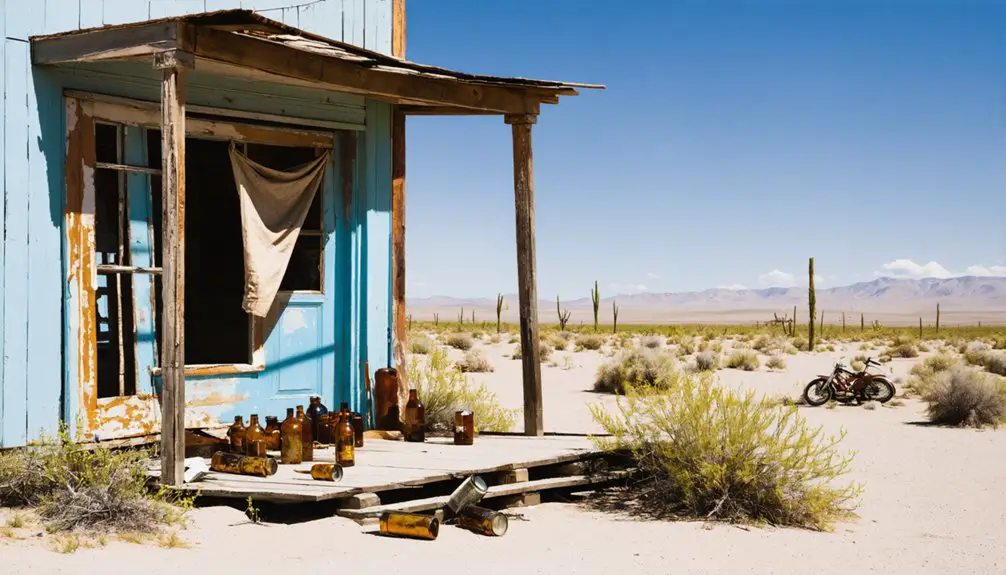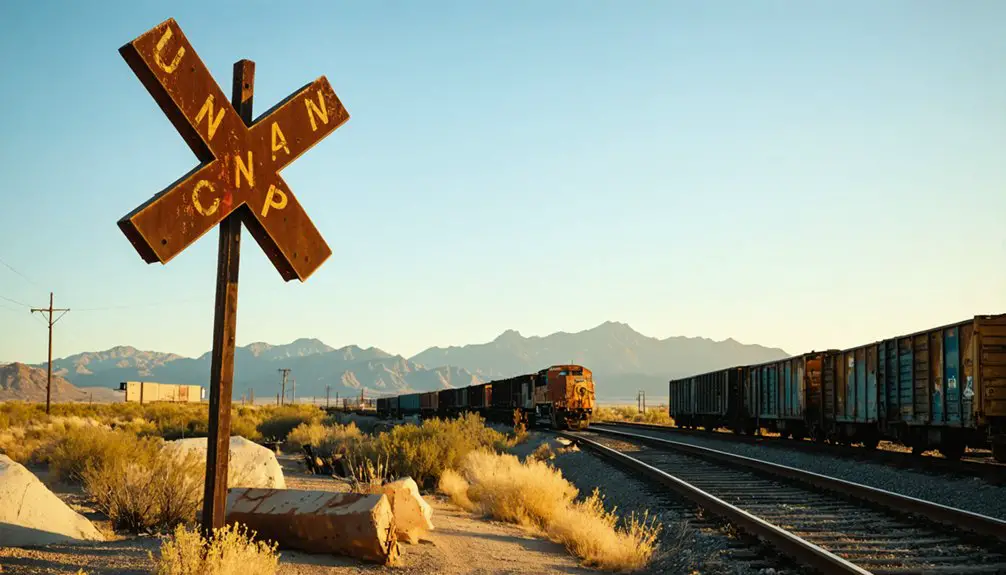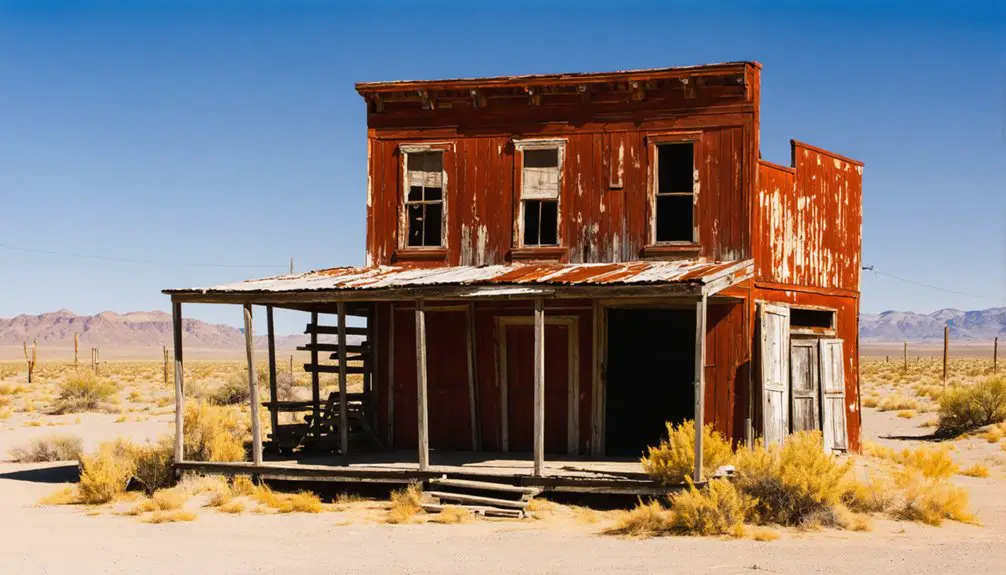You won’t find Hawthorne, Nevada on any ghost town lists – it’s very much alive as a bustling military community of 4,500 residents. Founded in 1880 as a railroad town during Nevada’s mining boom, it transformed in 1930 when the U.S. Navy established America’s largest ammunition depot there. While the town thrives today, you’ll discover fascinating ghost town ruins and abandoned mining camps scattered throughout the surrounding desert landscape. The story of Hawthorne’s evolution from frontier whistle-stop to military hub holds countless historical treasures.
Key Takeaways
- Hawthorne, Nevada is not a ghost town but rather an active community with over 4,500 residents in Mineral County.
- Founded in 1880 as a railroad town, Hawthorne survived while many neighboring mining communities became ghost towns.
- The town transformed from mining origins to military significance through the establishment of a massive ammunition depot in 1930.
- Despite population fluctuations, Hawthorne maintained vitality through its military presence, unlike abandoned mining settlements nearby.
- Historical mining ruins and camps near Hawthorne, including Pamlico and LaPanta mines, represent the area’s ghost town heritage.
The Railroad Town That Shaped Nevada’s Mining History
In the heart of Nevada’s mining country, Hawthorne emerged in 1880 as a significant railroad town that would forever change the state’s mineral transportation landscape. Founded by H.M. Yerington for the Carson and Colorado Railroad, this strategic settlement quickly proved its railroad significance as an essential distribution point between major mining camps.
You’ll find Hawthorne’s mining impact written in every chapter of its early story. Originally planned as Millbrae but renamed after pioneer William A. Hawthorne, the town welcomed its first train in 1861 carrying enthusiastic lot buyers. The community flourished rapidly and became the Esmeralda County seat in 1883. Today, it houses the world’s largest depot for storing military ammunition, spanning nearly 150,000 acres.
Positioned perfectly near Walker Lake on the Esmeralda Toll Road, it connected critical mining locations like Wadsworth and Candelaria. The town’s role as a transportation hub was important for shipping minerals, borax, and salt from nearby marshes, making it indispensable to Nevada’s mining economy.
From Esmeralda to Mineral: A Tale of Two Counties
You’ll find the story of Esmeralda and Mineral Counties intertwined at their historic courthouse, where shifting mining fortunes redrew county lines and redistributed political influence.
As Esmeralda’s population dwindled to under 1,000 residents by 2023, Mineral County emerged with over 4,500 people and stronger economic indicators, including higher property values and household incomes.
While both counties share deep mining heritage and rural character, their divergent paths reflect the westward migration of Nevada’s political and economic power, visible in everything from Mineral’s higher homeownership rates to its more diverse population, with 99.7 percent of residents being U.S. citizens.
The economic landscape remains heavily shaped by mining operations, with Mining and Extraction employing 80 workers and offering the highest average salaries at $92,917.
Courthouse Serves Dual Counties
Standing as Nevada’s only courthouse to serve two different counties, the historic Mineral County Courthouse in Hawthorne tells a compelling story of regional transformation.
You’ll find this remarkable dual county courthouse served as Esmeralda County’s seat from 1883 to 1907, before becoming Mineral County’s first courthouse in 1911. The courthouse history reflects the area’s dynamic changes during Nevada’s mining era.
Built in the Italianate style for $29,125, the building features distinctive architectural elements including buttressed sidewalls, arched windows, and a unique five-sided entry porch. Designed by contractor George W. Babcock, the final cost increased to $33,976 in total due to various project changes. The Carson & Colorado Railroad played a crucial role in establishing Hawthorne as a thriving station town.
While the 1930s brought modifications like a concrete vault and the removal of its cupola, the courthouse continued serving the community until 1970.
Though now condemned, this monument to frontier justice earned its place on the National Register of Historic Places in 1982.
Mining Drives County Changes
While early gold and silver discoveries in 1860 first drew miners to the Hawthorne area, it wasn’t until the Carson & Colorado Railroad‘s arrival in 1880 that the town truly began to take shape.
From 1904 to 1935, the district produced about 4,700 ounces of byproduct gold from the area’s silver mines.
You’ll find that mining economics drove dramatic county evolution in the region, as fortunes rose and fell with each new strike.
The town started with 500-600 residents by 1888, contrasting sharply with the surrounding barren plains.
When Goldfield’s population exploded to 20,000 during a major gold boom in 1907, you’d have witnessed a significant power shift.
The county seat moved from Hawthorne to Goldfield, but local leaders wouldn’t stand for this arrangement for long. They successfully lobbied the state legislature to create Mineral County in 1911, carved from Esmeralda’s northern section.
Once again, you’d find Hawthorne serving proudly as a county seat, this time for the newly formed Mineral County.
Political Power Shifts West
Before Hawthorne became Mineral County‘s seat of power, the political landscape of central Nevada centered on Esmeralda County, one of the state’s original nine counties established in 1861.
You’ll find it fascinating how the region’s political dynamics shifted westward as mining booms and population movements reshaped the territory.
As Aurora’s influence waned, the creation of Mineral County marked a decisive change in regional governance. A massive territory spanning 275 by 140 miles defined early Esmeralda County’s original boundaries, though much of it remained unexplored and seemingly worthless. The area’s complex history includes double elections, court disputes, and financial challenges that tested early settlers’ resolve.
While Esmeralda’s legislative representation diminished over time, Mineral County’s star rose with Hawthorne’s emergence as its administrative heart.
It’s a story of how economic forces and demographic changes transformed the political map, forever altering the balance of power in central Nevada.
Military Transformation and the Army Depot Era
After the devastating ammunition explosion at Lake Denmark in 1926, the U.S. Navy recognized the need for a safer ammunition storage facility. They chose Hawthorne, Nevada‘s remote location as the perfect spot, transforming this small mining town into a bustling military hub.
The depot’s military legacy began in 1930, with its sprawling 327-square-mile complex of bunkers and magazines. Private security contractors now guard the massive facility and its critical military assets.
You’d hardly recognize Hawthorne during World War II, when the population swelled to over 13,000. The transformation impact was profound as more than 5,600 workers managed the nation’s largest ammunition depot.
Even today, you’ll find over 2,900 storage magazines spread across 150,000 acres. While the facility shifted from Navy to Army control in 1977, it continues to serve as America’s premier ammunition storage and disposal site.
Ghost Towns and Historical Remnants Around Hawthorne

You’ll find the ghost town of Thorne, a former Southern Pacific Railroad station, just northwest of modern Hawthorne where two saloons once served travelers and miners in the early 1900s.
Mining ruins and camps scatter the surrounding hills, with the remnants of the Poinsettia Mine still visible along dirt roads radiating from town.
At these historical sites, you can walk among weathered foundations, rusty equipment, and other artifacts that tell the story of Mineral County’s rich mining heritage.
Thorne’s Railroad Legacy
The bustling railroad town of Thorne emerged in the early 1900s when Southern Pacific Railroad purchased and realigned the Carson & Colorado line south of Walker Lake. This strategic realignment transformed a simple whistle-stop into a crucial transportation hub, complete with a four-track crossing and two saloons serving neighboring communities like Aurora, Lucky Boy, and Bodie.
You’ll find Thorne’s significance peaked during World War II when it became one of Southern Pacific’s busiest stations, handling up to 5,000 rail cars monthly to support the Hawthorne Naval Ammunition Depot.
The railroad innovations included converting from narrow to standard gauge tracks, enabling increased mining traffic from booming towns like Tonopah and Goldfield.
Today, only scattered remnants remain – a wooden barn, railroad signposts, and foundations marking where this once-thriving community stood.
Poinsettia Mining Camp Today
While Thorne’s railroad legacy lives on through its remaining structures, another fascinating piece of Hawthorne’s mining heritage sits nestled in a steep, round basin northeast of town.
The Poinsettia Mining Camp, active from 1929 to 1944, stands as a symbol of Nevada’s mercury mining era. You’ll find the remnants of the hoist house and miners’ cabins still dotting the landscape, preserved through dedicated efforts by local Boy Scouts since the 1980s.
Unlike the region’s bustling boomtowns, Poinsettia never grew into a proper settlement, making it a unique window into the simpler side of mining life.
Today, you can explore this rugged site via off-road trails, where the authentic ruins offer a glimpse into the challenging world of early 20th-century mineral extraction.
Mining Ruins Near Hawthorne
Scattered across the rugged terrain around Hawthorne, historic mining ruins tell stories of Nevada’s gold and silver rush era dating back to the 1860s.
You’ll find the remains of the Pamlico and LaPanta mines just 10 miles east-southeast of town, where miners once extracted over $700,000 in precious metals. These ghost town exploration sites showcase foundations of ore-processing facilities and weathered mine shafts, particularly in the Lucky Boy Pass area.
The region’s mining heritage extends to the volcanic landscapes of Aurora Crater, where you can discover the haunting remnants of a once-bustling town of 10,000 souls.
In Limekiln Canyon, you’ll spot a surviving kiln and building foundations, though vandalism has claimed most original structures over the decades.
Transportation Networks and Regional Development

Located at an essential crossroads in Nevada’s transportation history, Hawthorne emerged in 1880 when H.M. Yerington established it as a depot for the Carson & Colorado Railroad.
This strategic location, at Walker Lake’s southern tip, became one of the West’s vital logistic hubs, supporting the region’s mining boom towns.
You’ll find Hawthorne’s transportation evolution marked by these defining features:
- The narrow-gauge railroad’s conversion to standard gauge in 1905
- Integration of the historic Esmerelda Toll Road with rail networks
- Development of stagecoach routes through points like Elbow Jakes
- Southern Pacific’s acquisition transforming regional rail patterns
- Military depot establishment cementing the town’s strategic importance
The convergence of rail lines, stage routes, and later military transport needs guaranteed Hawthorne’s pivotal role in Nevada’s development, even as nearby mining towns faded into history.
Life in Nevada’s Desert Mining Hub
Desert winds whispered through Hawthorne’s bustling streets during its 1880s mining heyday, as the town emerged as an essential hub serving the region’s rich gold and silver districts.
You’d find yourself among prospectors and railroad workers, all drawn to this oasis of economic resilience where the Carson and Colorado Railroad connected fortune-seekers to the promising mines of Pamlico and LaPanta.
The community dynamics centered around William A. Hawthorne’s leadership as Justice of the Peace, while the town provided crucial services to the surrounding mining camps.
You could witness the ebb and flow of population as mining fortunes shifted, yet Hawthorne’s spirit persisted through both booms and busts.
Even after losing its Esmeralda County seat to Goldfield in 1907, the town rebounded when it became Mineral County’s seat in 1911.
Frequently Asked Questions
What Was the Average Salary of Railroad Workers in 1880S Hawthorne?
Like a paymaster’s gold-filled chest, your railroad wages in 1880s economy would’ve varied – from $1.00 daily for basic laborers to $70 monthly for engineers, with skilled workers earning $2-3 daily.
How Many Original Buildings From 1880S Hawthorne Still Stand Today?
From historic preservation records, you’ll find only one original building with true architectural significance still stands today – the 1883 Esmerelda County Courthouse that served your pioneering community’s early days.
What Indigenous Tribes Lived in the Hawthorne Area Before Settlement?
Imagine walking ancestral fishing paths along Walker Lake. The Agai Dicutta Numa (Walker River Paiute), known as “Trout Eaters,” established their indigenous culture and historical significance here before settlers arrived in the 1880s.
Which Natural Disasters Have Significantly Impacted Hawthorne Throughout Its History?
You’ll find surprisingly few major natural disasters in the records, though the 1906 floods damaged critical roads. Beyond sporadic flooding impacts, there’s no significant earthquake effects in Hawthorne’s documented history.
What Were the Most Popular Entertainment Venues in Early Hawthorne?
You’d find the liveliest spots at Old Joe’s Tavern, El Capitan Casino, and the Cactus Theater, where saloon culture thrived. Dance halls and taverns near transport hubs kept the community’s spirits high.
References
- https://travelnevada.com/ghost-town/poinsettia-ghost-town/
- https://nvtami.com/2024/11/16/thorne-nevada-ghost-town/
- https://shpo.nv.gov/nevadas-historical-markers/historical-markers/hawthorne
- https://en.wikipedia.org/wiki/Hawthorne
- https://forgottennevada.org/sites/hawthorne.html
- https://www.nevadaappeal.com/news/2020/oct/21/the-nevada-traveler-hawthorne-more-to-it-than-meet/
- https://bouldercityreview.com/community/nevadas-yesteryear-mines-spurred-trains-construction-71240/
- https://www.nvnaco.org/wp-content/uploads/Esmeralda-County-Opioid-Community-Needs-Assessment-and-Plan-Approved-121923.pdf
- https://datausa.io/profile/geo/esmeralda-county-nv
- https://datausa.io/profile/geo/mineral-county-nv



